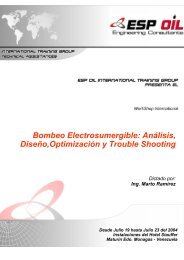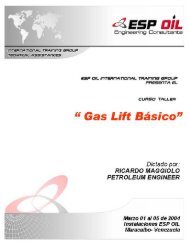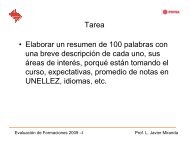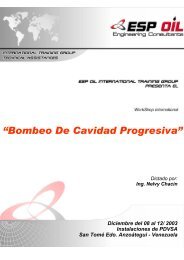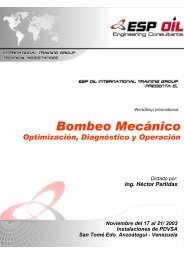Módulo III Evaluación de Formaciones Integrada - LIBROS DE ...
Módulo III Evaluación de Formaciones Integrada - LIBROS DE ...
Módulo III Evaluación de Formaciones Integrada - LIBROS DE ...
You also want an ePaper? Increase the reach of your titles
YUMPU automatically turns print PDFs into web optimized ePapers that Google loves.
MÓDULO <strong>III</strong><br />
EVALUACIÓN <strong>DE</strong><br />
FORMACIONES<br />
INTEGRADA<br />
Evaluación <strong>de</strong> <strong>Formaciones</strong> 2009 -II<br />
Ing. L. Javier Miranda, MSc
Parte 1<br />
Parte 2<br />
: Introducción<br />
: Revisión n <strong>de</strong> Registros <strong>de</strong> Pozos<br />
Contenido<br />
Módulo 1<br />
Parte 3<br />
: Porosidad<br />
Parte 4<br />
Parte 5<br />
: Permeabilidad<br />
: Saturación n <strong>de</strong> Fluidos<br />
Módulo 2<br />
Parte 6<br />
: Otras Propieda<strong>de</strong>s Petrofísicas<br />
Parte 7<br />
: Evaluación n <strong>de</strong> <strong>Formaciones</strong> <strong>Integrada</strong> con Registros <strong>de</strong> Pozos, Datos <strong>de</strong><br />
Núcleo, Pruebas <strong>de</strong> Presión n y Datos <strong>de</strong> Producción<br />
Módulo 3<br />
Parte 8<br />
: Nuevas Tecnologías y Metodologías<br />
Evaluación <strong>de</strong> <strong>Formaciones</strong> 2009 -II<br />
Ing. L. Javier Miranda, MSc
Activida<strong>de</strong>s <strong>de</strong>l Curso<br />
Módulo I:<br />
Evaluación n escrita 25%<br />
Módulo 2 : Evaluación n escrita 25%<br />
Módulo 3 : Evaluación n escrita 20%<br />
Módulo 3 : Exposición 20%<br />
Apreciación n <strong>de</strong>l instructor: 10%<br />
Asistencia, participación n e iniciativa, entre otros, serán n tomadas en cuenta<br />
en la apreciación n <strong>de</strong>l instructor<br />
Evaluación <strong>de</strong> <strong>Formaciones</strong> 2009 -II<br />
Ing. L. Javier Miranda, MSc
CONTENIDO<br />
Metodología para la realización <strong>de</strong> un mo<strong>de</strong>lo petrofísico<br />
Determinación <strong>de</strong> la Resistividad <strong>de</strong>l Agua (Rw)<br />
Calibración Núcleo - Perfil<br />
Determinación <strong>de</strong> los mo<strong>de</strong>los <strong>de</strong> litología, arcillosidad, porosidad,<br />
saturación <strong>de</strong> agua y permeabilidad<br />
Evaluación <strong>de</strong> formaciones limpias<br />
Evaluación <strong>de</strong> formaciones arcillosas<br />
Determinación <strong>de</strong> los parámetros <strong>de</strong> corte<br />
Cálculo <strong>de</strong> propieda<strong>de</strong>s petrofísicas promedio (conteo <strong>de</strong> arenas)<br />
Elaboración <strong>de</strong> mapas <strong>de</strong> isopropieda<strong>de</strong>s<br />
Cálculo <strong>de</strong>l POES<br />
Evaluación <strong>de</strong> <strong>Formaciones</strong> 2009 -II<br />
Ing. L. Javier Miranda, MSc
Metodología para la Realización <strong>de</strong> un<br />
Mo<strong>de</strong>lo Petrofísico<br />
Revisión Bibliográfica<br />
Realización <strong>de</strong>l Inventario <strong>de</strong> Registros <strong>de</strong> Pozos<br />
Estimación <strong>de</strong> parámetros petrofísicos básicos<br />
Cálculo <strong>de</strong> Rw<br />
Determinación <strong>de</strong> m, n, a y <strong>de</strong>nsidad <strong>de</strong> matriz<br />
Revisión <strong>de</strong> información <strong>de</strong> núcleos<br />
Establecimiento <strong>de</strong>l Mo<strong>de</strong>lo Mineralógico<br />
Calibración Núcleo – Perfil (Estimación <strong>de</strong> Porosidad y Permeabilidad)<br />
Determinación <strong>de</strong> Tipos <strong>de</strong> Rocas<br />
Definición <strong>de</strong> Petrofacies<br />
Caracterización <strong>de</strong>l Radio <strong>de</strong> Garganta Poral<br />
Evaluación <strong>de</strong> <strong>Formaciones</strong> 2009 -II<br />
Ing. L. Javier Miranda, MSc
Metodología para la Realización <strong>de</strong> un<br />
Mo<strong>de</strong>lo Petrofísico (Cont. 1)<br />
Determinación <strong>de</strong> los mo<strong>de</strong>los petrofísicos a emplear<br />
Mo<strong>de</strong>lo <strong>de</strong> Litología<br />
Mo<strong>de</strong>lo <strong>de</strong> Arcillosidad<br />
Mo<strong>de</strong>lo <strong>de</strong> Porosidad<br />
Mo<strong>de</strong>lo <strong>de</strong> Saturación <strong>de</strong> Agua<br />
Mo<strong>de</strong>lo <strong>de</strong> Permeabilidad<br />
Evaluaciones petrofísicas por pozos<br />
Validación <strong>de</strong> las evaluaciones petrofísicas en los pozos<br />
con núcleos, registros especiales, pruebas <strong>de</strong> formación y<br />
datos <strong>de</strong> producción<br />
Extrapolación a los Pozos sin Núcleos<br />
Control <strong>de</strong> Calidad <strong>de</strong> las Evaluaciones Petrofísicas<br />
Evaluación <strong>de</strong> <strong>Formaciones</strong> 2009 -II<br />
Ing. L. Javier Miranda, MSc
Metodología para la Realización <strong>de</strong> un<br />
Mo<strong>de</strong>lo Petrofísico (Cont. 2)<br />
Determinación <strong>de</strong> Parámetros <strong>de</strong> Corte<br />
Determinación Gráfica<br />
Validación Cualitativa <strong>de</strong> los Resultados<br />
Cuantificación <strong>de</strong> Propieda<strong>de</strong>s Petrofísicas<br />
Elaboración <strong>de</strong> mapas <strong>de</strong> Isopropieda<strong>de</strong>s<br />
Mapas Isópacos <strong>de</strong> Arena Neta<br />
Mapas Isópacos <strong>de</strong> Arena Neta Petrolífera<br />
Mapas <strong>de</strong> Arcillosidad<br />
Mapas <strong>de</strong> Porosidad<br />
Mapas <strong>de</strong> Permeabilidad<br />
Cálculo <strong>de</strong>l POES<br />
Evaluación <strong>de</strong> <strong>Formaciones</strong> 2009 -II<br />
Ing. L. Javier Miranda, MSc
Determinación <strong>de</strong> la Resistividad <strong>de</strong>l Agua<br />
<strong>de</strong> Formación (Rw)<br />
• Medición Directa<br />
• Análisis Físico – Químico<br />
• Método SP<br />
• Método Rwa<br />
• Método <strong>de</strong>l “Pickett Plot”<br />
• Relación <strong>de</strong> Resistivida<strong>de</strong>s<br />
• Catálogos o archivos <strong>de</strong> aguas <strong>de</strong> formación<br />
Evaluación <strong>de</strong> <strong>Formaciones</strong> 2009 -II<br />
Ing. L. Javier Miranda, MSc
¿Qué es el agua <strong>de</strong> formación?<br />
1. Medición Directa<br />
El agua <strong>de</strong> formación o agua <strong>de</strong> producción está asociada con el petróleo existente<br />
en los yacimientos y sale a la superficie junto con el gas y el petróleo. Esta agua<br />
tiene las siguientes características:<br />
Usualmente es caliente y con un alto contenido <strong>de</strong> sales.<br />
Pue<strong>de</strong> contener metales pesados, altos niveles <strong>de</strong> sales y fracciones <strong>de</strong><br />
crudo en emulsión o dilución.<br />
Pue<strong>de</strong> ser radioactiva<br />
Debe ser reinyectada o tratada apropiadamente para evitar daños ambientales y<br />
a la salud.<br />
Pue<strong>de</strong> contaminar el agua subterránea <strong>de</strong> consumo humano.<br />
Evaluación <strong>de</strong> <strong>Formaciones</strong> 2009 -II<br />
Ing. L. Javier Miranda, MSc
2. Análisis Físico – Químico<br />
PHYSICAL CHEMICAL WATER ANALYSIS<br />
CATIONS mg/l meq/l<br />
Potasium, K 200 5.12<br />
Barium, Ba 15.0 0.22<br />
Calcium, Ca 280.00 13.97<br />
Magnesium, Mg 53.00 4.38<br />
Iron, Fe 0.1 0.00<br />
Strontium, Sr 26.0 0.59<br />
Sodium, Na 1950 84.82<br />
0.9<br />
TOTAL CATIONES 2524 109.10<br />
Chlori<strong>de</strong>, Cl<br />
Sulfate, SO 4<br />
ANIONS<br />
Bicarbonate, HCO3<br />
Carbonate, CO3<br />
Hidroxi<strong>de</strong>, OH<br />
TOTAL ANIONS<br />
Total Solids<br />
Concentration<br />
mg/l meq/l<br />
3741 105.53<br />
0.1 0.00<br />
190 3.11<br />
0 0.00<br />
0 0<br />
3931.1 108.65<br />
6455 ppm<br />
Tomado <strong>de</strong> “Schlumberger Log Interpretation Charts” (2000)<br />
Evaluación <strong>de</strong> <strong>Formaciones</strong> 2009 -II<br />
Ing. L. Javier Miranda, MSc
2. Análisis Físico – Químico (Cont.)<br />
PHYSICAL CHEMICAL WATER ANALYSIS<br />
0.88<br />
CATIONS mg/l meq/l ANIONS mg/l meq/l<br />
Potasium, K 200 5.12 Chlori<strong>de</strong>, Cl 3741 105.53<br />
Barium, Ba 15.0 0.22 Sulfate, SO 4 0.1 0.00<br />
Calcium, Ca 280.00 13.97 Bicarbonate, HCO3 190 3.11<br />
Magnesium, Mg 53.00 4.38 Carbonate, CO3 0 0.00<br />
Iron, Fe 0.1 0.00 Hidroxi<strong>de</strong>, OH 0 0<br />
Strontium, Sr 26.0 0.59 TOTAL ANIONS 3931.1 108.65<br />
Sodium, Na 1950 84.82<br />
TOTAL CATIONES 2524 109.10 PROPERTIES RESULTADOS UNIDA<strong>DE</strong>S<br />
pH 8.0<br />
HARDNESS mg/l Specific Gravity 1.0020 g/cm 3<br />
Calcium 699 Conductivity @ 25 o C 11370.00 umhos/cm<br />
Magnesium 218 Resistivity @ 25 o C 0.88 Ohms/m<br />
Total 917 Salinity Total 6114 mg/l<br />
Total Dissolved Solids 6455 mg/l<br />
ALKALINITY mg/l Turbidity 86 NTU<br />
Phenolpthalein 0 Color real 17 Pt-Co<br />
Total 156 Saturation Langelier 0.92<br />
Saturation Riznar 6.11<br />
25ºC<br />
Evaluación <strong>de</strong> <strong>Formaciones</strong> 2009 -II<br />
Tomado <strong>de</strong> “Schlumberger Log Interpretation Charts” (2000)<br />
Ing. L. Javier Miranda, MSc
3. Método SP<br />
La curva <strong>de</strong> SP pue<strong>de</strong> ser usada para <strong>de</strong>terminar Rw si se cumple con las<br />
siguientes condiciones:<br />
El espesor <strong>de</strong> la capa es a<strong>de</strong>cuado (preferiblemente una capa<br />
gruesa) o la lectura <strong>de</strong> SP ha sido corregida por capas vecinas.<br />
La arena <strong>de</strong>be ser acuífera (Sw = 100%), por en<strong>de</strong>, <strong>de</strong>be tener una<br />
resistividad baja.<br />
La arena <strong>de</strong>be ser limpia o libre <strong>de</strong> arcilla y permeable.<br />
SSP<br />
=<br />
Rmfe<br />
( 61+<br />
0.133•<br />
Tfm)<br />
• Log(<br />
Rwe<br />
)<br />
Evaluación <strong>de</strong> <strong>Formaciones</strong> 2009 -II<br />
Ing. L. Javier Miranda, MSc
3. Método SP (Cont.)<br />
Evaluación <strong>de</strong> <strong>Formaciones</strong> 2009 -II<br />
Ing. L. Javier Miranda, MSc
3. Método SP (Cont.)<br />
Conversión <strong>de</strong> Rwe a Rw algebraicamente<br />
Evaluación <strong>de</strong> <strong>Formaciones</strong> 2009 -II<br />
Ing. L. Javier Miranda, MSc
SSP=<br />
Rmfe<br />
(61+0.133• Tfm) • Log( )<br />
Rwe<br />
3. Método SP (Cont.)<br />
Evaluación <strong>de</strong> <strong>Formaciones</strong> 2009 -II<br />
Ing. L. Javier Miranda, MSc
4. Método Rwa<br />
Evaluación <strong>de</strong> <strong>Formaciones</strong> 2009 -II<br />
Ing. L. Javier Miranda, MSc
5. Método <strong>de</strong>l “Pickett Plot”<br />
log Rt = -m log Φ + log ( a *Rw ) - n log Sw<br />
Evaluación <strong>de</strong> <strong>Formaciones</strong> 2009 -II<br />
Ing. L. Javier Miranda, MSc
6. Relación <strong>de</strong> Resistivida<strong>de</strong>s<br />
Evaluación <strong>de</strong> <strong>Formaciones</strong> 2009 -II<br />
Ing. L. Javier Miranda, MSc
7. Catálogos o Archivos <strong>de</strong> Aguas <strong>de</strong><br />
Formación<br />
The i<strong>de</strong>a for a formation water resistivity catalog began circa 1964 when<br />
Schlumberger of Canada published the first Rw Catalog for their field<br />
engineers. Prior to that, most major oil companies each had their own<br />
collections of Rw Data. The 1964 edition was so popular that it was<br />
expan<strong>de</strong>d and revised in 1966. In 1971, the CWLS published their first<br />
formation water catalog based on Schlumberger's previous works. This<br />
was followed by updates in 1978 and 1987.<br />
The 2002 Edition of the Rw Catalog has taken almost four years to<br />
complete. The objectives of the update:<br />
1. Add new values (new areas and new wells)<br />
2. Correct known errors<br />
3. Append additional information (formation and interval)<br />
4. Establish a procedure to facilitate updates<br />
5. Publish electronically<br />
Evaluación <strong>de</strong> <strong>Formaciones</strong> 2009 -II<br />
Ing. L. Javier Miranda, MSc
7. Catálogos o Archivos <strong>de</strong> Aguas <strong>de</strong><br />
Formación (Cont.)<br />
Mapa<br />
Isosalínico<br />
(Isoconnático)<br />
Tomado <strong>de</strong> Ing. De Yacimientos, Pirson (1958)<br />
Evaluación <strong>de</strong> <strong>Formaciones</strong> 2009 -II<br />
Ing. L. Javier Miranda, MSc
Determinación <strong>de</strong>l Exponente <strong>de</strong><br />
Cementación (m)<br />
Litología y Factor <strong>de</strong> Cementación<br />
Revisar el Módulo II: Propieda<strong>de</strong>s <strong>de</strong> las Rocas<br />
Tomado <strong>de</strong> Ing. De Yacimientos, Pirson (1958)<br />
Evaluación <strong>de</strong> <strong>Formaciones</strong> 2009 -II<br />
Ing. L. Javier Miranda, MSc
Determinación <strong>de</strong>l Exponente <strong>de</strong><br />
Cementación (m)<br />
Factor <strong>de</strong> Formación vs. Porosidad<br />
Revisar el Módulo II: Propieda<strong>de</strong>s <strong>de</strong> las Rocas<br />
Tomado <strong>de</strong> Ing. De Yacimientos, Pirson (1958)<br />
Evaluación <strong>de</strong> <strong>Formaciones</strong> 2009 -II<br />
Ing. L. Javier Miranda, MSc
Calibración Núcleo – Perfil<br />
Evaluación <strong>de</strong> <strong>Formaciones</strong> 2009 -II<br />
Ing. L. Javier Miranda, MSc
Calibración Núcleo – Perfil (Cont.)<br />
Evaluación <strong>de</strong> <strong>Formaciones</strong> 2009 -II<br />
Ing. L. Javier Miranda, MSc
Determinación <strong>de</strong>l Mo<strong>de</strong>lo Litológico<br />
Litología simples<br />
Arenas Limpias<br />
Arenas Arcillosas<br />
Litologías complejas<br />
Carbonatos (Calizas, Dolomías)<br />
<strong>Formaciones</strong> heterolíticas (mezclas <strong>de</strong> diferentes litologías)<br />
Evaluación <strong>de</strong> <strong>Formaciones</strong> 2009 -II<br />
Ing. L. Javier Miranda, MSc
Distribución <strong>de</strong> las Arcillas<br />
Evaluación <strong>de</strong> <strong>Formaciones</strong> 2009 -II<br />
Ing. L. Javier Miranda, MSc
Tipos y Distribución <strong>de</strong> la Arcilla Dispersa<br />
Reducción menor<br />
<strong>de</strong> Φ y k<br />
Reducción menor <strong>de</strong> Φ<br />
Reducción significativa <strong>de</strong> k<br />
Reducción significativa <strong>de</strong> Φ<br />
Reducción drástica <strong>de</strong> k<br />
Evaluación <strong>de</strong> <strong>Formaciones</strong> 2009 -II<br />
Ing. L. Javier Miranda, MSc
Determinación <strong>de</strong>l Mo<strong>de</strong>lo <strong>de</strong> Arcillosidad<br />
• A partir <strong>de</strong> GR<br />
• Deflección <strong>de</strong>l Gamma Ray<br />
IGR=(GR-GRclean)/(GRshale-GR clean)<br />
1) Vsh = 1.7 – (3.38 – (IGR + 0.7) 2 ) 1/2<br />
Clavier (1971)<br />
2) Vsh = 0.5*IGR / (1.5 – IGR)<br />
Steiber (1961)<br />
3) Vsh = 0.33 (2 2*IGR – 1)<br />
Larionov (Pre-terciario)<br />
4) Vsh = 0.083 (2 3.7*IGR – 1)<br />
Larionov (Terciario)<br />
Evaluación <strong>de</strong> <strong>Formaciones</strong> 2009 -II<br />
Ing. L. Javier Miranda, MSc
Determinación <strong>de</strong>l Mo<strong>de</strong>lo <strong>de</strong> Arcillosidad<br />
• A partir <strong>de</strong> Densidad - Neutrón<br />
(Vsh) D/N = (Φn - Φd)/(Φnsh - Φdsh)<br />
Evaluación <strong>de</strong> <strong>Formaciones</strong> 2009 -II<br />
Ing. L. Javier Miranda, MSc
Determinación <strong>de</strong>l Mo<strong>de</strong>lo <strong>de</strong> Porosidad<br />
• Porosidad <strong>de</strong>l Sónico<br />
• Raymond – Hunt<br />
Øs = (∆t - ∆tma) / (∆t f - ∆tma)<br />
φs = 0.63 * [1 - (∆tma / ∆t)]<br />
• Porosidad <strong>de</strong>l Densidad<br />
Φd = (ρma – ρb)/(ρma – ρf)<br />
• Porosidad <strong>de</strong>l Densidad Neutrón<br />
Φe=[(Φdc 2 + Φnc 2 )/2] ½<br />
Φdc= Φd – Φdsh * Vcl<br />
Φnc= Φn – Φnsh * Vcl<br />
Evaluación <strong>de</strong> <strong>Formaciones</strong> 2009 -II<br />
Ing. L. Javier Miranda, MSc
Determinación <strong>de</strong>l Mo<strong>de</strong>lo <strong>de</strong> Sw<br />
Arcillas Laminadas<br />
Arcillas Dispersas (Simandoux)<br />
Arcillas Dispersas (Waxman - Smits)<br />
Evaluación <strong>de</strong> <strong>Formaciones</strong> 2009 -II<br />
Ing. L. Javier Miranda, MSc
Determinación <strong>de</strong>l Mo<strong>de</strong>lo <strong>de</strong> Sw (Cont.)<br />
MO<strong>DE</strong>LO <strong>DE</strong><br />
ARCHIE<br />
Arena Limpia<br />
Zona Contentiva<br />
agua<br />
S<br />
n<br />
w<br />
a*<br />
Rw<br />
=<br />
m<br />
φ * R<br />
t<br />
MO<strong>DE</strong>LOS <strong>DE</strong><br />
VOLUMEN <strong>DE</strong><br />
ARCILLA<br />
Arena con alto<br />
grado <strong>de</strong><br />
arcillosidad y agua<br />
fresca <strong>de</strong><br />
formación.<br />
Arcillas Laminadas<br />
Arcillas Dispersas (Simandoux Modificada)<br />
Evaluación <strong>de</strong> <strong>Formaciones</strong> 2009 -II<br />
Ing. L. Javier Miranda, MSc
Determinación <strong>de</strong>l Mo<strong>de</strong>lo <strong>de</strong> Sw (Cont.)<br />
MO<strong>DE</strong>LOS <strong>DE</strong><br />
CAPACIDAD<br />
<strong>DE</strong><br />
INTERCAMBIO<br />
CATIONICO<br />
Arena Arcillosa<br />
Agua Alre<strong>de</strong>dor <strong>de</strong> la Arcilla<br />
Agua <strong>de</strong> formación<br />
Arcillas Dispersas (Waxman – Smits, 1968)<br />
Evaluación <strong>de</strong> <strong>Formaciones</strong> 2009 -II<br />
Ing. L. Javier Miranda, MSc
Mo<strong>de</strong>lo <strong>de</strong> Waxman Smits<br />
Sw: Saturación <strong>de</strong> agua <strong>de</strong> la zona virgen, fracción.<br />
Rt: Resistividad verda<strong>de</strong>ra <strong>de</strong> la zona virgen, ohm-m.<br />
Rw: Resistividad <strong>de</strong>l agua <strong>de</strong> formación, ohm-m.<br />
Φ: Porosidad, fracción.<br />
m: Factor <strong>de</strong> cementación corregido por arcillosidad, adim.<br />
n: Exponente <strong>de</strong> saturación corregido por arcillosidad, adim.<br />
a: Constante <strong>de</strong> Archie, adim.<br />
Qv: Capacidad <strong>de</strong> intercambio catiónico en la zona virgen,<br />
meq/cc.<br />
B: Conductancia equivalente <strong>de</strong> la zona (calculada en base<br />
a la temperatura y Rw), adim. Se obtiene a partir <strong>de</strong> la<br />
siguiente ecuación:<br />
T: Temperatura <strong>de</strong> la formación.<br />
Rw: Resistividad <strong>de</strong>l agua <strong>de</strong> formación, ohm-m.<br />
Evaluación <strong>de</strong> <strong>Formaciones</strong> 2009 -II<br />
Ing. L. Javier Miranda, MSc
Mo<strong>de</strong>lo <strong>de</strong> Doble Agua<br />
Don<strong>de</strong>:<br />
Swt = Saturación <strong>de</strong> agua total corregida por arcillosidad<br />
Sb = Saturación <strong>de</strong> agua asociada a las arcillas <strong>de</strong> la arena<br />
Rw = Resistividad <strong>de</strong>l agua <strong>de</strong> formación<br />
Rb = Resistividad <strong>de</strong>l agua asociada a las arcillas <strong>de</strong> una lutita cercana<br />
Rt = Resistividad verda<strong>de</strong>ra<br />
Φt = Porosidad total <strong>de</strong> la arena arcillosa<br />
Φtsh = Porosidad total <strong>de</strong> la fracción <strong>de</strong> arcilla en la arena<br />
Evaluación <strong>de</strong> <strong>Formaciones</strong> 2009 -II<br />
Ing. L. Javier Miranda, MSc
Determinación <strong>de</strong> Parámetros <strong>de</strong> Corte<br />
• Gráfica Rt Vs. Sw<br />
RT c = 32 Ohm-m<br />
SUWI i = 0,08<br />
SUWI c = 0,58<br />
Evaluación <strong>de</strong> <strong>Formaciones</strong> 2009 -II<br />
Ing. L. Javier Miranda, MSc
Determinación <strong>de</strong> Parámetros <strong>de</strong> Corte<br />
• Gráfica Vcl Vs. Sw<br />
VCL c = 0,55<br />
SUWI i = 0,08<br />
SUWI c = 0,58<br />
Evaluación <strong>de</strong> <strong>Formaciones</strong> 2009 -II<br />
Ing. L. Javier Miranda, MSc
Determinación <strong>de</strong> Parámetros <strong>de</strong> Corte<br />
• Gráfica Phie Vs. Sw<br />
PIGN c = 0,13<br />
SUWI c = 0,58<br />
Evaluación <strong>de</strong> <strong>Formaciones</strong> 2009 -II<br />
Ing. L. Javier Miranda, MSc
Determinación <strong>de</strong> Parámetros <strong>de</strong> Corte<br />
• Gráfica K Vs. Phie<br />
Saturación <strong>de</strong> agua: SUWIc < 0,58<br />
Resistividad verda<strong>de</strong>ra: RTc > 32 Ohm-m<br />
Volumen <strong>de</strong> arcilla: VCLc < 0,55<br />
Porosidad efectiva: PIGNc > 0,13<br />
Permeabilidad intrínseca: KINTc > 70 mD<br />
Saturación <strong>de</strong> agua irreducible: SUWIi = 0,08<br />
KINT c = 70 mD<br />
PIGN c = 0,13<br />
Evaluación <strong>de</strong> <strong>Formaciones</strong> 2009 -II<br />
Ing. L. Javier Miranda, MSc
Validación <strong>de</strong> Parámetros <strong>de</strong> Corte<br />
LVT-1X<br />
LEYENDA:<br />
Resistividad<br />
mínima<br />
Permeabilidad<br />
mínima<br />
Porosidad<br />
mínima<br />
Saturación <strong>de</strong> agua<br />
máxima<br />
Volumen <strong>de</strong> arcilla<br />
máximo<br />
Intervalo<br />
cañoneado<br />
INTERVALO ANT(Pies) ANP(Pies) PHIE (V/V) VCL (V/V) SW (V/V) K(mD)<br />
9429,82 - 9497,9 55 21,5 0,176 0,332 0,486 229,608<br />
Evaluación <strong>de</strong> <strong>Formaciones</strong> 2009 -II<br />
Ing. L. Javier Miranda, MSc
Cuantificación <strong>de</strong> Propieda<strong>de</strong>s Petrofísicas<br />
Promedio<br />
POZO<br />
TOPE (pies) BASE (pies) ANT (Pies) ANP (Pies) PHIE (V/V) PHIE (V/V) VCL (V/V) SW (V/V) K (mD) CAP. ALM. CAP. FLUJO.<br />
TVDSS TVDSS TVD TVD ANT ANP ANY ANP ANP (pies) (mD-pies)<br />
LVT-1X 8882,82 8950,90 55,00 21,50 0,18 0,18 0,33 0,49 229,61 1,94 12628,44<br />
LVT-2X 9422,51 9489,01 36,00 0,00 0,22 0,35 0,00<br />
LVT-3X 9139,91 9198,14 42,50 0,00 0,18 0,35 0,00<br />
LVT-4X 8643,45 8713,22 31,50 22,50 0,23 0,18 0,36 0,38 167,68 2,47 5281,83<br />
LVT-5X 9179,88 9240,18 44,37 0,00 0,22 0,37 0,00<br />
LVT-6 8849,46 8885,90 2,07 1,46 0,21 0,24 0,18 0,21 563,66 0,28 1164,48<br />
LVT-7 8695,69 8771,30 28,14 18,77 0,23 0,24 0,31 0,23 634,50 3,53 17857,07<br />
LVT-8 8682,27 8763,00 26,78 15,30 0,16 0,16 0,33 0,42 124,83 1,41 3342,43<br />
LVT-9 8795,33 8865,55 35,26 20,38 0,21 0,22 0,32 0,45 513,42 2,42 18102,88<br />
LVT-10 8661,70 8711,17 3,69 0,00 0,20 0,25 0,00<br />
LVT-11 8744,65 8803,20 8,98 8,98 0,14 0,14 0,29 0,24 88,23 0,95 792,69<br />
LVT-12 8760,57 8822,31 11,74 4,61 0,18 0,15 0,37 0,49 87,25 0,34 1024,53<br />
LVT-13 8686,19 8730,12 0,00 0,00 0,00 0,00<br />
LVT-14 8668,83 8711,09 0,00 0,00 0,00 0,00<br />
LVT-15 8636,29 8713,88 28,56 28,56 0,16 0,16 0,24 0,38 154,53 2,94 4413,88<br />
LVT-16 8738,61 8816,68 31,30 24,10 0,17 0,17 0,24 0,40 122,59 2,45 3837,20<br />
LVT-17 8794,63 8852,28 1,08 1,08 0,13 0,13 0,06 0,40 2,28 0,09 2,47<br />
LVT-18 8605,44 8660,28 0,00 0,00 0,00 0,00<br />
LVT-19 8666,33 8743,19 6,98 6,98 0,14 0,14 0,23 0,47 105,14 0,53 733,96<br />
LVT-20 8850,67 8921,35 26,93 19,65 0,20 0,20 0,38 0,33 398,07 2,62 10718,98<br />
LVT-21 8722,66 8795,97 33,98 31,48 0,19 0,19 0,40 0,36 291,15 3,89 9893,57<br />
LVT-22 8756,64 8838,99 5,37 0,00 0,17 0,37 0,00<br />
LVT-23 8865,78 8925,14 17,25 9,19 0,25 0,19 0,26 0,41 312,42 1,00 5390,38<br />
LVT-25 8729,84 8809,42 9,17 7,79 0,16 0,15 0,29 0,48 112,15 0,60 1028,06<br />
LVT-26 8755,02 8807,73 0,00 0,00 0,00 0,00<br />
LVT-27 8841,25 8909,40 5,12 0,00 0,16 0,30 0,00<br />
LVT-28 8667,98 8749,88 27,50 21,00 0,17 0,17 0,32 0,33 143,90 2,46 3957,36<br />
LVT-29 8707,52 8754,19 0,00 0,00 0,00 0,00<br />
LVT-30 8602,76 8664,10 14,12 3,41 0,20 0,23 0,22 0,56 691,00 0,35 9756,81<br />
LVT-31 8653,69 8710,33 5,09 0,00 0,19 0,13 0,00<br />
LVT-32 8683,26 8753,49 26,00 24,00 0,17 0,17 0,32 0,36 163,92 2,65 4261,87<br />
LVT-33 8623,04 8674,51 0,00 0,00 0,00 0,00<br />
LVT-34 8625,87 8694,34 24,00 22,50 0,20 0,20 0,33 0,23 361,89 3,41 8685,46<br />
LVT-35 8735,68 8795,19 12,50 12,50 0,15 0,15 0,48 0,13 125,52 1,62 1568,98<br />
LVT-37 8589,88 8659,77 14,51 14,05 0,18 0,18 0,35 0,16 136,66 2,14 1983,44<br />
LVT-39 8629,84 8698,05 44,08 42,63 0,21 0,21 0,37 0,17 336,99 7,49 14854,89<br />
PROM 8758,22 8822,31 18,32 10,62 0,19 0,18 0,30 0,35 255,10 1,32 4871,78<br />
Evaluación <strong>de</strong> <strong>Formaciones</strong> 2009 -II<br />
Ing. L. Javier Miranda, MSc
Elaboración <strong>de</strong> Mapas <strong>de</strong> Isopropieda<strong>de</strong>s<br />
Mapa <strong>de</strong> Isoporosidad<br />
Mapa <strong>de</strong> Isopermeabilidad<br />
Evaluación <strong>de</strong> <strong>Formaciones</strong> 2009 -II<br />
Ing. L. Javier Miranda, MSc
-8850'<br />
-8950'<br />
.)<br />
14'<br />
14'<br />
'92<br />
'88<br />
'84<br />
Elaboración <strong>de</strong> Mapas <strong>de</strong> Isopropieda<strong>de</strong>s<br />
• Mapa <strong>de</strong> Reservas (Estructural e Isópaco <strong>de</strong> ANP)<br />
"32<br />
"36<br />
7+10,04-<br />
/71+27,43-<br />
/71+26,00-<br />
/71+24,00-<br />
/71+22,19-<br />
7+10,04-<br />
7+10,00-<br />
7+10,00-<br />
APUR-V6 APUR-V7 APUR-V8 APUR-V9<br />
APUR-V11<br />
APUR-V12<br />
APUR-V13<br />
APUR-V14<br />
7+06,00-<br />
7+08,00-<br />
'84 '88 '92<br />
APUR-V15 APUR-V16 APUR-V17<br />
APUR-V18<br />
APUR-V20<br />
YAC.ARA INF LVT 1<br />
APUR-V21<br />
LVT 26 LVT 52<br />
-8520'<br />
-8501'<br />
8'<br />
8'<br />
8'<br />
8'<br />
LVT 53D1 -8510'<br />
LVT 10<br />
16'<br />
-8560'<br />
16'<br />
4' LVT 54D LVT17D LVT 17<br />
4' -8479' LVT 53<br />
24' -8496' -8559'<br />
24' 19' -8524'<br />
13'<br />
19' 18' 13'<br />
18'<br />
LVT 13<br />
LVT 12 LVT 31 -8494'<br />
-8543'<br />
-8475' 13'<br />
6'<br />
16' 13'<br />
6'<br />
LVT 29 16'<br />
-8492'<br />
8'<br />
8'<br />
LVT 14<br />
-8451'<br />
0' LVT 33<br />
0'<br />
LVT 11<br />
-8481'<br />
-8543' LVT 35 LVT 40_2 0'<br />
0' -8550'<br />
-8477' 0'<br />
0'<br />
0'<br />
0'<br />
LVT 32 0'<br />
0'<br />
-8514'<br />
LVT 18 -8447'<br />
6'<br />
LVT4X LVT 49<br />
7'<br />
6'<br />
7'<br />
-8503' -8456'<br />
LVT 9<br />
LVT 30_2<br />
7' 7'<br />
7'<br />
LVT 30_1<br />
7'<br />
-8560'<br />
-8455'<br />
0'<br />
7'<br />
0'<br />
LVT 38<br />
7'<br />
LVT 28<br />
-845 2'<br />
LVT 8<br />
9'<br />
-8485'<br />
9'<br />
-8556'<br />
20' LVT 37<br />
8'<br />
20'<br />
-8443'<br />
8'<br />
5'<br />
LVT 20<br />
LVT 15<br />
5'<br />
-8470' F<br />
-8615'<br />
14'<br />
14'<br />
LVT 39<br />
12'<br />
LVT 46_2<br />
LVT 7<br />
-8461'<br />
12'<br />
-8474'<br />
4'<br />
8'<br />
4'<br />
-8545'<br />
8' LVT 34<br />
APUR-V24 APUR-V25<br />
8'<br />
-8482'<br />
APUR-V26<br />
5'<br />
APUR-V27<br />
8'<br />
LVT 36 5'<br />
LVT 19<br />
-8494'<br />
8'<br />
-8506'<br />
LVT 23<br />
8'<br />
0'<br />
LVT 22<br />
0'<br />
LVT 43<br />
-8639'<br />
20'<br />
-8645'<br />
15'<br />
15'<br />
LVT 25RE<br />
-8548'<br />
14'<br />
14'<br />
LVT 2X<br />
-8695'<br />
LVT 1X<br />
-8617'<br />
9'<br />
18'<br />
9'<br />
0'<br />
-8655'<br />
-9027'<br />
30'<br />
LVT 43D<br />
0'<br />
APUR-V29 APUR-V30<br />
-8657'<br />
LVT-45<br />
9'<br />
APUR-V31 APUR-V32<br />
-8599'<br />
9'<br />
LVT 42 6' LVT 41<br />
6'<br />
5'<br />
10'<br />
30'<br />
LVT-50<br />
-8900'<br />
-8642'<br />
11'<br />
LVT 44<br />
11'<br />
LVT 47<br />
-8629'<br />
26'<br />
26'<br />
-8850'<br />
-8800'<br />
LVT 24<br />
NR<br />
'(EST<br />
CAPO @ -8708<br />
-8627'<br />
25'<br />
25'<br />
LVT 48<br />
-8633'<br />
25'<br />
25'<br />
-8750'<br />
-8634'<br />
9'<br />
9'<br />
30'<br />
25'<br />
5'<br />
-8600'<br />
20'<br />
LVT 21 S<br />
-8533'<br />
33'<br />
33'<br />
LVT 27<br />
-9000'<br />
-8560'<br />
15'<br />
15'<br />
-8950'<br />
5'<br />
-8900'<br />
10'<br />
5'<br />
LVT 25<br />
-8565'<br />
10'<br />
10'<br />
CAPO @ -8708'(E<br />
15'<br />
-8500'<br />
20'<br />
LVT 6<br />
-8569'<br />
12'<br />
12'<br />
-8500'<br />
15'<br />
10'<br />
5'<br />
LVT-51<br />
-8500'<br />
5'<br />
LVT-51 ST<br />
-8460'<br />
12'<br />
12'<br />
LVT 16<br />
-8519'<br />
5'<br />
5'<br />
5'<br />
-8600'<br />
5'<br />
10'<br />
-9650'<br />
-9700'<br />
10'<br />
5'<br />
15'<br />
20'<br />
10'<br />
-9550'<br />
5'<br />
10'<br />
APUR-V22<br />
15'<br />
20'<br />
N<br />
APUR-V23<br />
7+08,00-<br />
7+06,00-<br />
POES<br />
-8900'<br />
-8950'<br />
-8647'<br />
33'<br />
33'<br />
-9000'<br />
-9100'<br />
-9200'<br />
-9150'<br />
-8750'<br />
-8800'<br />
Evaluación <strong>de</strong> <strong>Formaciones</strong> 2009 -II<br />
Ing. L. Javier Miranda, MSc
• Método Volumétrico<br />
Cálculo <strong>de</strong>l POES<br />
7758•A•ANP•Φ•(1<br />
POES =<br />
Boi<br />
Sw)<br />
Don<strong>de</strong>:<br />
7758: Factor <strong>de</strong> conversión a Barriles Normales (Bls/acres*pie)<br />
A: Área <strong>de</strong>l campo (Acres)<br />
ANP: Arena neta petrolífera (Pies)<br />
Φ: Porosidad Efectiva (Fracción)<br />
Sw: Saturación <strong>de</strong> agua (Fracción)<br />
Boi: Factor volumétrico inicial <strong>de</strong> petróleo<br />
O<br />
7758•A•ANP•Φ•(1<br />
VR NTG<br />
POES POES = =<br />
Boi<br />
Sw)<br />
Don<strong>de</strong>:<br />
VR: Volumen <strong>de</strong> Roca (Barriles)<br />
NTG: Net To Gross (Fracción)<br />
Φ: Porosidad Efectiva (Fracción)<br />
Sw: Saturación <strong>de</strong> agua (Fracción)<br />
Boi: Factor volumétrico inicial <strong>de</strong> petróleo<br />
NTG = ANP/ET<br />
Don<strong>de</strong>:<br />
NTG: Net To Gross<br />
ANP: Arena neta petrolífera (Pies)<br />
ET: Espesor Total (Pies)<br />
Evaluación <strong>de</strong> <strong>Formaciones</strong> 2009 -II<br />
Ing. L. Javier Miranda, MSc
MÓDULO <strong>III</strong><br />
EVALUACIÓN <strong>DE</strong><br />
FORMACIONES<br />
INTEGRADA<br />
FIN <strong>DE</strong>L MÓDULO<br />
Evaluación <strong>de</strong> <strong>Formaciones</strong> 2009 -II<br />
Ing. L. Javier Miranda, MSc



